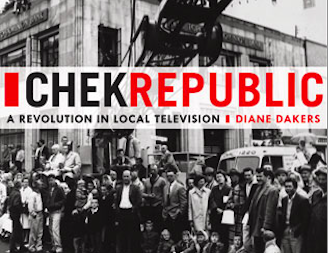Diane Dakers’ book outlines how the Victoria operation became the only employee-owned TV station in North America.
Diane Dakers, CHEK Republic: A Revolution in Local Television (Heritage House Publishing Co., 2014). Paperback, $19.95
By Vivian Smith
[[{“fid”:”3648″,”view_mode”:”default”,”fields”:{“format”:”default”,”field_file_image_alt_text[und][0][value]”:””,”field_file_image_title_text[und][0][value]”:””},”type”:”media”,”link_text”:null,”attributes”:{“height”:”487″,”width”:”315″,”style”:”margin-right: 10px; margin-left: 10px; font-size: 13.0080003738403px; line-height: 20.0063037872314px; width: 200px; height: 309px; float: right;”,”class”:”media-element file-default”}}]]
The story of how a Victoria television station ducks a corporate firing squad and lives to broadcast again meets the criteria for a movie—the rousing, affirming kind with a solid ensemble cast.
Do New York hedge-fund managers control the remains of a tattered media empire, including the money-bleeding station? Check.
Do local heroes rally to preserve a proud history of broadcasting to a community that other big markets ignore? In true B.C. style, do they ask pulp-mill workers to show them how to buy out their own employer? Check and check.
What about a dramatic sprint to get the employees’ (and investors’) money to the lawyers’ offices? Check.
Unlike most classic Hollywood tales, this is all true, down to the tears and applause in the station’s newsroom the day the employees took over in 2009. In her new book, CHEK Republic: A Revolution in Local Television, journalist Diane Dakers recounts how CHEK, a mid-sized television station in Victoria, became the first—and to date, only—employee-owned TV station in North America. The story made news across the country when more than 60 CHEK employees, along with local investors, fought hard to preserve their livelihoods rather than see then-owner Canwest shut the station down and fade it to black after more than half a century.
Its unique employees-as-owner status is not the station’s only claim to fame. CHEK went to air in 1956 as the first TV station on Vancouver Island. Broadcaster David Armstrong christened it CHEK for the promotional ring. “For instance, ‘Check channel 6 tonight,’” as he announced at the time. It was the province’s first independently owned station and the first in Canada that could broadcast in colour.
[node:related]
Over the years, CHEK has had five owners and been connected to three networks. Its name has changed three times: in 2001, during a Canwest Global rebranding exercise, it was simply called “CH.” Locals joked that two letters must have cost less than four. As is turned out, the realities of cost-cutting from (now defunct) Canwest’s misadventures in empire-building were no joke and very nearly killed CHEK.
CHEK brought a hyperlocal approach to news and programming decades before any web whiz coined the term, producing and broadcasting Island-focused newscasts, political affairs programs (this is the province’s capital, after all), live talk shows and even popular dance party shows for teens. Today, under the slogan “Your Island’s Own,” CHEK broadcasts local news in the afternoon and evening. A news agreement means CHEK also airs CBC news reports and shares the public broadcaster’s resources. The station produces local programming, including a cooking show that features the chef of a restaurant that sponsors the show, and a real estate and design show sponsored by a local realtor. But then, such are the necessary arrangements for cash-strapped community broadcasters everywhere. American programs such as Jeopardy!, religious shows and infomercials round out the schedule. The popular CHEK website features news, show highlights, contests, photos, polls and community activities.
The book’s tick-tock of the ownership deal has cinematic bright spots, but much of the action unfolds inside some heavy underbrush. We learn the intricacies and history of Canadian broadcast regulations and funding programs; the context of Canwest’s head-spinning negotiations with its impatient creditors; and the roles of the many players involved, from the station to Canwest executives to regulators, lawyers and investors. The book also started life as an academic research project. I know from experience that such roots can make a lively rewrite challenging. Dakers’ book is best read, therefore, as a business case study, meticulous in its detail and offering extensive proof of the uniqueness of the miracle wrought by CHEK and its supporters.
CHEK lit a fire under a particular community, one that is close to—but a strait away from—a big city, and with an insular culture. Its older, highly loyal audience stills sits down to watch the local news on a television set. In Victoria, the cost of living is so high you must be affluent to live here, which advertisers love. And who knows if the community that saved it may be able to do enough to ensure its long-term survival in an industry that struggles within the caprices of technology and the endless splintering of the media marketplace. As Dakers explains, it’s for these reasons this is one case study that may be impossible to replicate in Canada.
[[{“fid”:”3642″,”view_mode”:”default”,”fields”:{“format”:”default”,”field_file_image_alt_text[und][0][value]”:””,”field_file_image_title_text[und][0][value]”:””},”type”:”media”,”link_text”:null,”attributes”:{“height”:”511″,”width”:”480″,”style”:”width: 75px; height: 85px; margin-left: 10px; margin-right: 10px; float: left;”,”class”:”media-element file-default”}}]]Vivian Smith is a journalist and instructor at the University of Victoria’s Department of Writing. Her book, Outsiders Still: Why Women Journalists Love—and Leave—their Newspaper Careers, will be published this April by University of Toronto Press.

